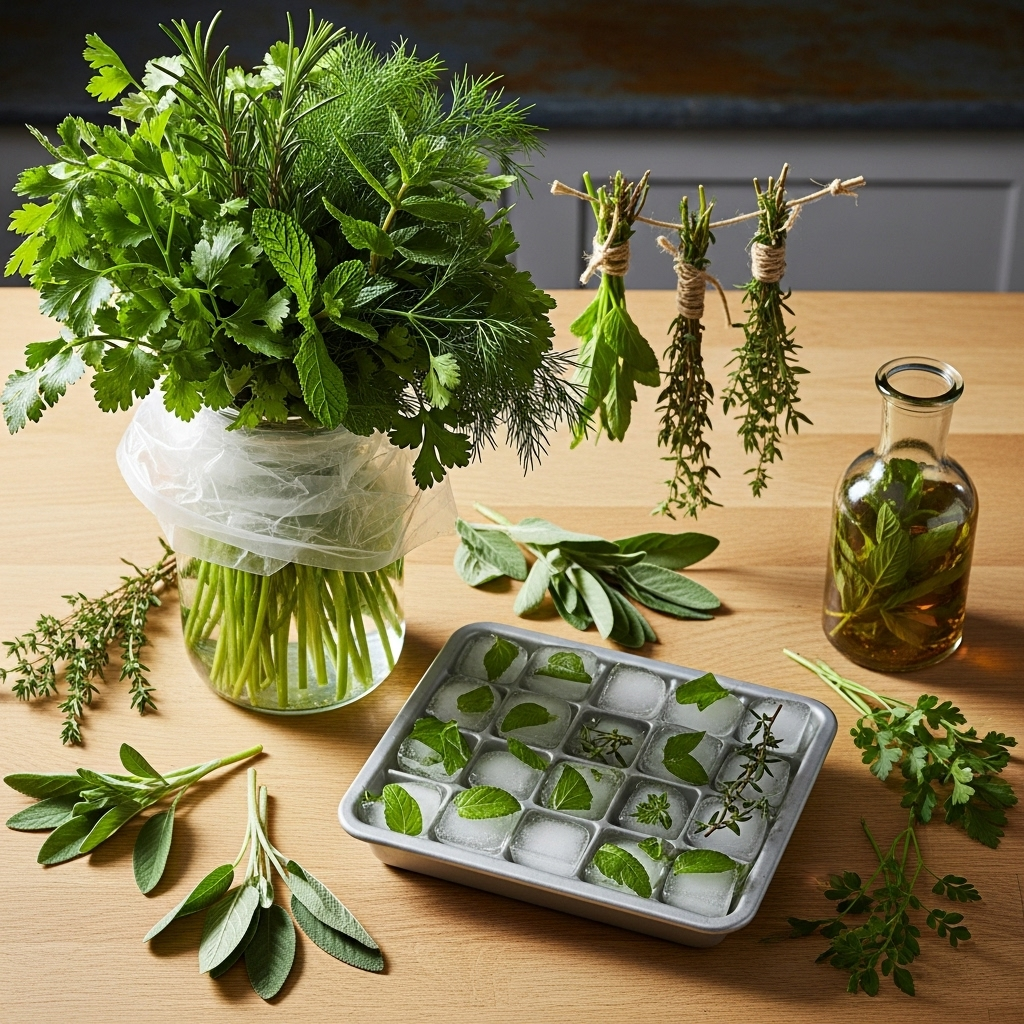Fresh herbs add vibrant flavor and aroma to any dish, but they can wilt and spoil quickly if not stored properly. To make the most of your herb harvest or grocery store find, preserving them is key.
Here are four easy and effective ways to keep your fresh herbs flavorful and ready to use for weeks or even months.
1. Refrigerate in a Herb Bouquet
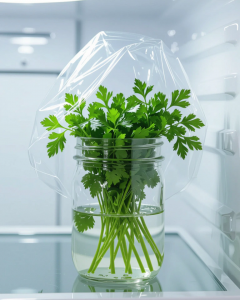
When I get home, I triage tender herbs first: parsley, coriander (cilantro), dill, mint, and sometimes basil.
- Trim 1 cm off the stems, stand the bunch in a clean jar with about an inch of cold water, and loosely tent the leaves with a food bag.
- Park the jar on a fridge shelf, not the door, so the temperature stays stable.
- Change the water every 1–2 days and re-trim stems if they start to brown.
This bouquet setup gives me 7–14 days for most tender herbs. A quick caveat on basil: it’s cold-sensitive.
If your fridge runs chilly, basil will blacken. Two options work for me: keep basil at room temperature on the counter in a jar of water with a loose bag tent, or refrigerate it briefly and use it within a couple of days.
Either way, keep the leaves dry, because moisture equals mush.
For “woody” herbs like rosemary, thyme, sage, and oregano, the bouquet method is optional. They also do well wrapped in a barely damp paper towel and sealed in a bag in the crisper drawer.
I use whatever slot I have free.
Pro tip: don’t wash herbs before the bouquet unless they’re gritty. If they need a rinse, spin them very dry first.
Excess surface moisture accelerates spoilage.
2. Freeze Herbs in Ice Cubes
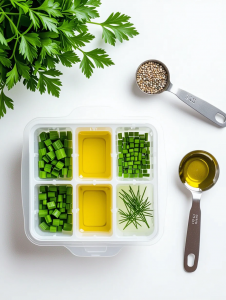
Freezing is my go-to for long-term retention of flavor with basically zero ongoing maintenance. This is how I batch it:
- Chop herbs finely (soft ones like parsley, dill, chives, coriander) or strip leaves from woody stems and chop them.
- Add about 1 tablespoon of herbs per cube to an ice tray and top with cold water or olive oil. Water is great for soups and stews; oil is better for sautés and sauces.
- Freeze solid, then pop the cubes into a labeled freezer bag.
They keep their punch for 3–6 months. Basil keeps its color better if you blanch the leaves for 5–10 seconds, shock in ice water, pat dry, then chop and freeze in oil.
If that sounds like unnecessary ceremony, yes, but the greener result is worth it for pesto and pasta.
Ratios I like: 1 tablespoon herbs to 1 tablespoon liquid per cube. That gives me predictable “doses.”
I drop cubes straight into a hot pan or warm sauce. No thawing, no sad, slimy clumps.
3. Dry Herbs Naturally
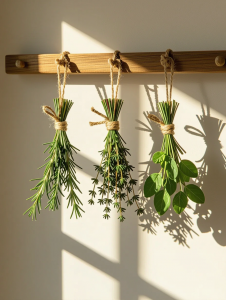
Drying concentrates flavor and clears space in the fridge. It’s the best fit for rosemary, thyme, oregano, marjoram, sage, bay, and lavender.
- Make small bundles (thicker bundles trap moisture), tie with kitchen string, and hang them upside down in a warm, dry, airy spot, away from direct sunlight.
- Depending on humidity, drying takes 7–14 days. They’re done when leaves crumble cleanly and stems snap.
- Strip the leaves, store them in airtight jars, label with the herb and date, and keep the jars in a cool, dark cupboard.
Dried herbs stay vibrant for about 6–12 months. After that, they’re still safe, just sleepy.
Crushing a little between your fingers will tell you if the aroma is still working for you. When cooking with dried herbs, I usually start with one-third the amount I’d use fresh, then adjust to taste.
A quick win: dry your own mixed Italian-style seasoning. I combine equal parts dried oregano, basil, marjoram, thyme, and a little crushed rosemary.
It’s reliable, and I control the freshness.
4. Make Herb-Infused Oils or Vinegars
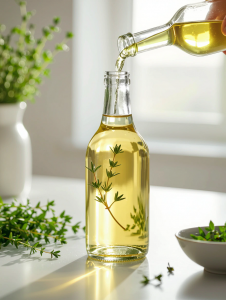
Infused vinegars are a dream for dressings and quick pan sauces, and infused oils add a finishing lift. There’s a safety nuance here that’s not negotiable:
- Vinegar: The acidity makes this straightforward. Pack clean, dry herbs into a sterilized bottle, cover fully with vinegar (white wine, red wine, apple cider, or rice vinegar), seal, and leave in a cool, dark place for 1–3 weeks. I taste weekly. Once the flavor lands where I want it, then strain, rebottle, and label. Stored cool and dark, it’s happy for several months.
- Oil: Oil plus fresh, water-bearing herbs stored at room temperature can create conditions for botulism. Not the sort of surprise anyone wants. Two safe pathways:
- Use dried herbs for room-temperature oil infusions. Strain after 1–2 weeks, then store cool and dark.
- For fresh herbs, make a “quick oil”: bruise the herbs, warm gently with oil on the hob for 5–10 minutes (don’t fry), cool, strain, and refrigerate. Use within 1–2 weeks. I label the jar and keep it near the front so I don’t forget it.
Garlic has the same rules as fresh herbs: quick oil, then fridge only, and use promptly.
If in doubt, I freeze herb oil in cubes like in method 2. It preserves bright flavor and keeps food safety clean and simple.
How I Choose the Right Method
I break herbs into two buckets:
- Tender: parsley, coriander, dill, basil, mint, chives, tarragon.
Best: bouquet in water (fridge for most, counter for basil), or freeze in cubes. Drying is underwhelming for these because their delicate aromas fade when dried. - Woody: rosemary, thyme, oregano, sage, marjoram, bay.
Best: air-drying or freezing. They tolerate the paper-towel-in-bag crisper trick for short-term storage.
If I’ve overbought, I’ll often do a mixed strategy the same day: half into a bouquet for immediate cooking, half into the freezer for the month ahead.
Shelf-life Benchmarks
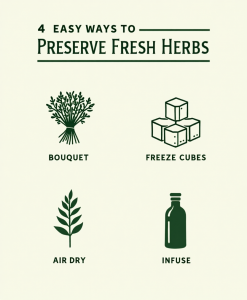
- Herb bouquet (tender): 7–14 days
- Crisper drawer, damp towel (woody): 10–14 days
- Frozen cubes (water or oil): 3–6 months
- Dried herbs: 6–12 months at peak
- Infused vinegar: several months, stored cool and dark
- Quick herb oil (fresh herbs): 1–2 weeks refrigerated
These are practical ranges, not fantasy lab numbers. Always trust your senses: if it looks slimy or smells off, it’s not a negotiation.
Quick Deployment Ideas
- Drop a parsley-garlic oil cube into a hot pan, add prawns, finish with lemon.
- Stir a dill-water cube into a salmon chowder at the end so the herb stays bright.
- Toss roasted potatoes with a sage-oil cube and flaky salt while they’re still hot.
- Whisk 1 tablespoon rosemary vinegar with 3 tablespoons olive oil and a pinch of mustard for a fast green-salad dressing.
- Crumble dried thyme over roast veg before they hit the oven; the heat wakes it up.
Troubleshooting and Quality Assurance
- Herbs turning black in the bouquet: likely too cold or too wet. Looser bag tent, drier leaves, or move basil to room temperature.
- Mold on drying herbs: bundles were too thick or the space was too humid. Make smaller bundles and increase airflow.
- Frozen herbs taste flat: they were stored too long or freezer-burned. Use thicker bags, press out air, and label with a realistic use-by date.
- Infused oil tastes dull: herbs were old or over-heated. Start with fresh, aromatic herbs and keep the oil just warm, not sizzling.
Why This Matters Beyond Flavor
Preserving herbs reduces food waste and saves money. It also speeds up midweek cooking, because future-you already did the prep.
If you cook for family or clients, having a pipeline of prepped herbs levels up consistency. You get fresh flavor on demand, not just the week you shopped with ambition.
That’s the playbook I use at home. Start with the bouquet to stabilize this week’s herbs, move surplus straight to the freezer, dry the woody stems you won’t touch for a while, and craft a couple of infusions to keep dressings interesting.
It’s simple operational excellence, but in your kitchen. Once you run this process a couple of times, it becomes second nature and your herbs stop ghosting you after 48 hours.
Happy cooking, and enjoy stretching every last bit of flavor from those greens.

